Perception Versus Reality: What Are The Key Drivers Of Sales Effect?
Click here to view a 12-minute video of the key findings.
Westwood One recently commissioned Advertiser Perceptions to survey 305 brands and media agencies to indicate the percentage of sales contribution generated by each of these six advertising elements:
- Brand
- Context
- Creative
- Reach
- Recency
- Targeting
How would you answer? What percent of sales are driven by each? Answers should add up to 100%.
Marketer and media agency perception: Among the 305 marketers and media agencies, targeting is seen to drive 22% of sales, the greatest contributor, followed by brand (18%), creative (17%), and reach (17%).
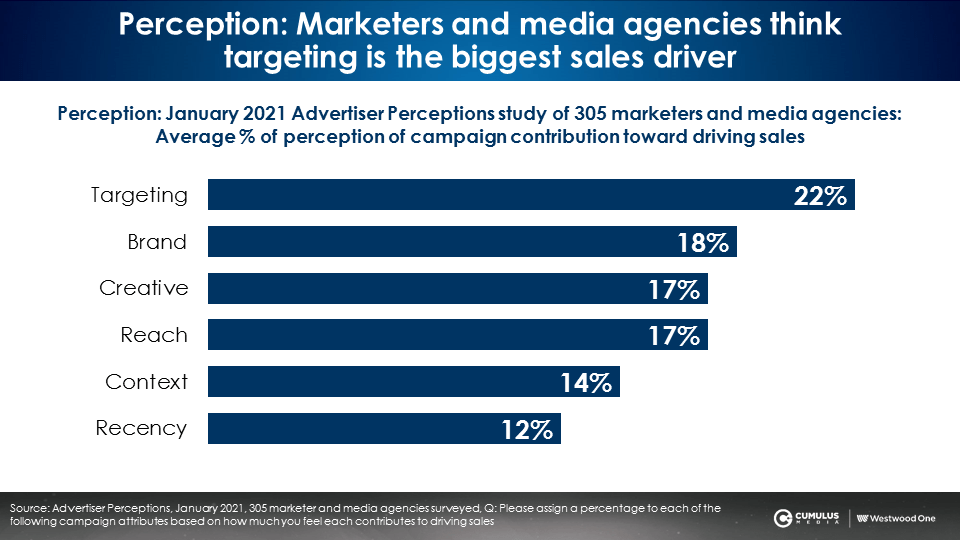
Science versus perception: How do marketer/media agency estimates of what contributes to sales compare to actual sales effect data?
To determine what actually drives advertising effectiveness, we turn to one of largest and most prominent studies ever conducted on sales effect. The Five Keys to Advertising Effectiveness, presented by NCSolutions and Nielsen, is based on nearly 500 studies and over a decade of experience linking advertising to sales results. The study was conceived and led by Leslie Wood, Chief Research Officer at NCSolutions.
Targeting: Marketers and media agencies overestimate the impact of targeting by 2.5X
Marketers and media agencies consider targeting the number one sales driver at a 22% contribution. Per Nielsen, targeting is a distant third generating only 9% of sales effect.
Perhaps the recent industry handwringing over the loss of mobile ad IDs and third-party cookies is misplaced. The hubbub seems overwrought given that targeting is such a small lever, generating only 9% of sales effect.
The best-selling marketing and media strategy book How Not To Plan: 66 Ways to Screw It Up from Les Binet and Sarah Carter cautions, “Don’t target too narrowly. It may be efficient, but it’s rarely effective. Tight targeting means low sales and profits.”
Writing in MediaPost, Elyse Kane, Professor at Baruch College and former Vice President, Insights and Analytics at Colgate Palmolive, notes there are three “watch-outs” with targeting:
- “Many companies mis-define their targets
- Many companies define their targets too narrowly
- People aren’t static, they move in and out of targets”
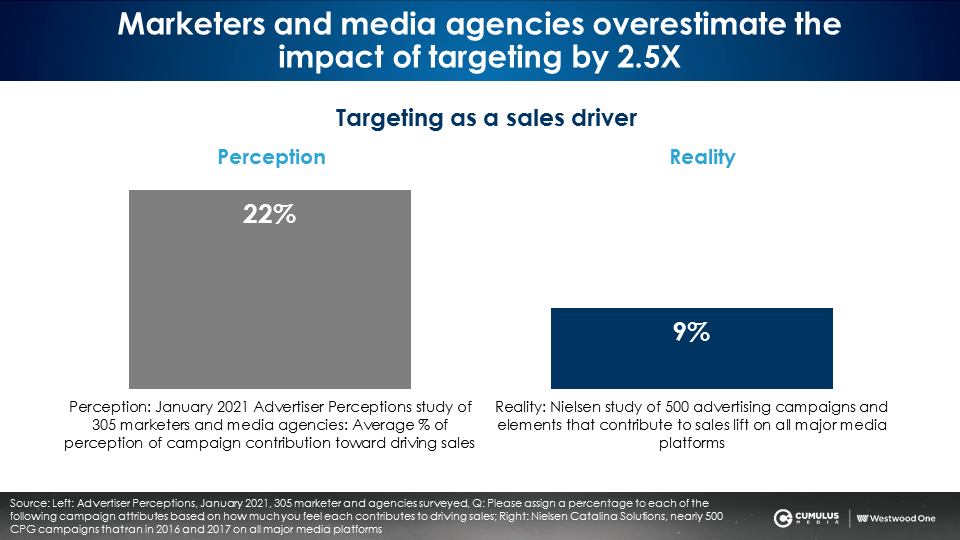
Context/recency: The perceived impact of context and recency as sales drivers is overestimated
Marketers and media agencies think context and recency represent 26% of combined sales effect. Nielsen reveals the two elements only generate 7% of sales.
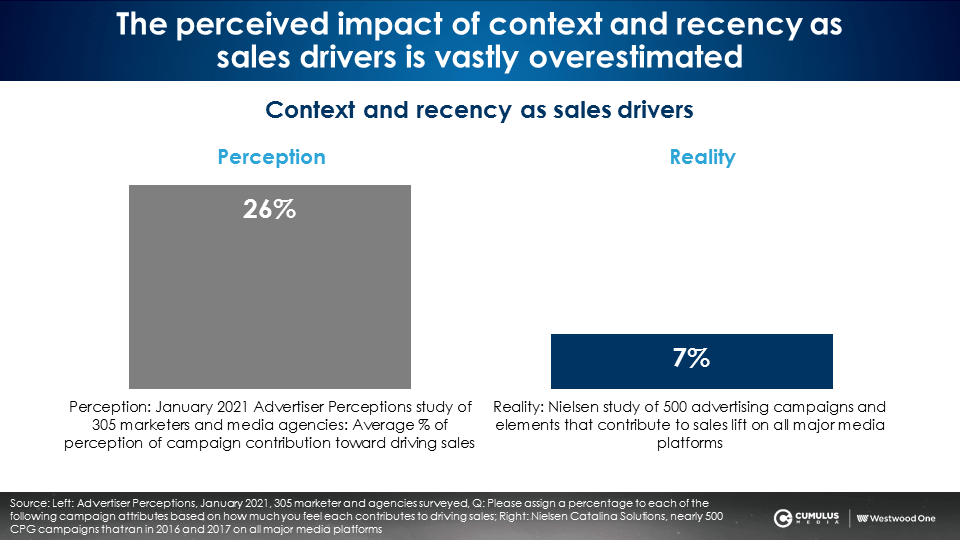
Reach: The sales effect of reach is underestimated by marketers and media agencies
Per Nielsen, reach is by far the number one media sales driver contributing 22% of sales versus the 17% perception among brands and agencies.
Charlie Rudd, Chief Executive Officer of Leo Burnett London, states that advertising “build[s] businesses by creating large customer numbers keen to buy into what a brand offers. We mobilize and persuade large groups of people to act.”
In How Not To Plan: 66 Ways to Screw It Up, Les Binet and Sarah Carter recommend:
- “Always aim to get more customers from all segments of the market. It’s the main way brands grow.
- Talk to everyone who buys your category. Talk to them regularly. Advertising memories fade.
- Go for reach, rather than frequency. Reach as many category buyers as possible.”
WARC, the organization that devotes itself to the study of marketing effectiveness, proclaims in their “Anatomy of Effectiveness” report, “Reach is the foundation of media effectiveness.”
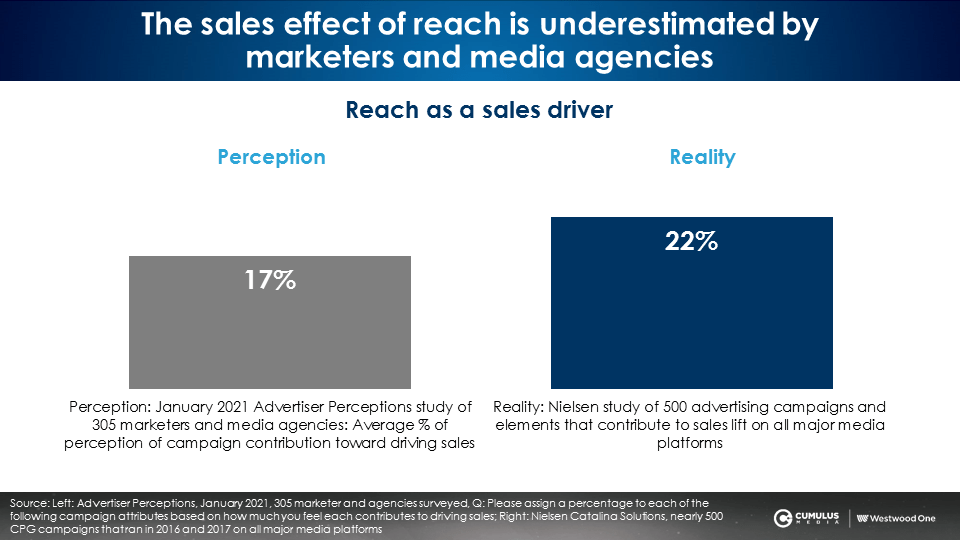
Broad versus narrow targeting: The P&G memo that was ripped up and thrown away
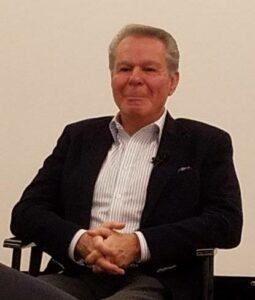
Irwin Gotlieb, former Global CEO and Chairman of GroupM
Photo taken by Pierre Bouvard
At an Advertising Research Foundation event, the legendary Irwin Gotlieb, former Global CEO and Chairman of GroupM, the world’s largest media agency, recounted an error he made as a young agency media executive recommending that P&G’s Pampers target narrowly rather than broadly:
“I’m the guy who wrote a memo to my P&G client when I was 27 years old saying that Pampers targeting was way too broad, that they should be focusing all their money on child-bearing-age females and skip everything else. … [Referring to the memo, the client] says, “This one, I’m just tearing up and throwing away. For your benefit, I’m never going to tell anyone you sent it.”
And I said “Why? I thought it was brilliant.” He said, “Look, it’s just a diaper. But you’re putting it on your infant and if you haven’t known about the brand since you were a child, you are not putting it on your infant. And if your mother doesn’t support your decision, you’re not putting it on your infant. And so, think more broadly and don’t be that stupid.”
“… Foundation principles in marketing continue to be relevant. They’re probably more relevant today than they ever have been. Yes, you have to do top of the funnel marketing. If you don’t have awareness, you can’t create consideration and you can’t create preference and you can’t create a transaction.”
Creative: Marketers and media agencies massively underestimate the immense sales effect power of creative
Creative, according to Nielsen, drives almost half of sales. This is nearly three times what media agencies and advertisers perceive.
Nielsen’s Leslie Wood says, “All of our work shows creative is central. The quality of the message and the way it resonates with consumers is at least half the battle. So, of course, creative matters more than share of voice. On the other hand, if you don’t ever share that creative, then the creative doesn’t matter. So, first get the creative right, then advertise to the right consumers.”
Marc Binkley, VP Digital and Marketing Strategy of Anstice Communications, says, “Creative is the closest thing we have to a silver bullet…it’s a way to supercharge budgets. Emotional, well-branded creative is a way to be more memorable. The goal isn’t awareness, it’s being memorable in as many buying situations as possible.”
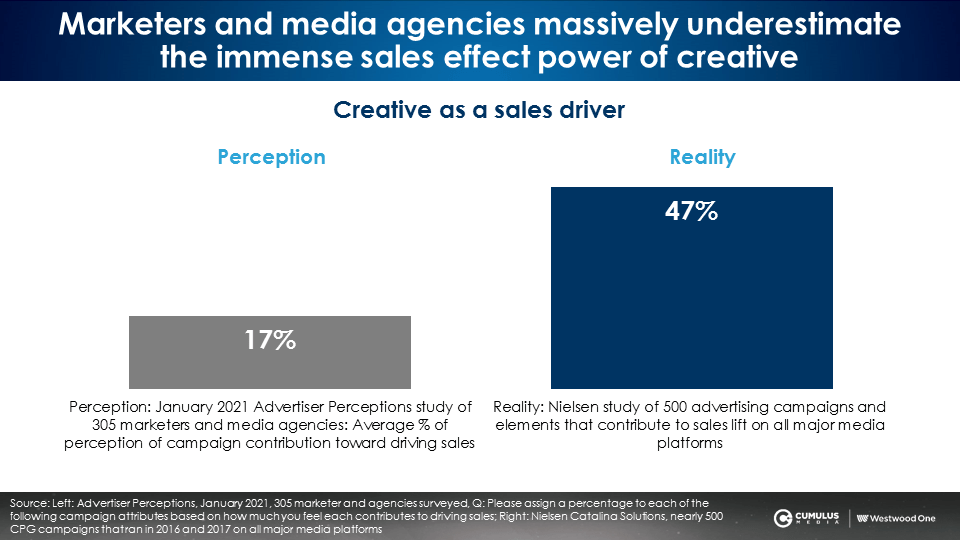
Howard Luck Gossage, the advertising visionary known as the “Socrates of San Francisco” said, “The buying of time or space is not the taking out of a hunting license on someone else’s private preserve but is the renting of a stage on which we may perform.”
In his new book about creative Why Does the Pedlar Sing? What Creativity Really Means in Advertising, author Paul Feldwick advises, “I would like to encourage all those who work in advertising and brand management to suspend their ‘delicate feelings’ about what really creates popularity and fame, and to embrace the idea that advertising is at least as much showmanship as it is salesmanship. It is time to rediscover the fact that advertising builds brands best when it is entertaining, popular and memorable, when it is not just a pitch, but a performance.”
At 69% of sales contribution, reach and creative generate the vast majority of sales effect
The contrast of NCSolutions’ Five Keys to Advertising Effectiveness with Advertiser Perceptions data reveals a major disconnect about what really generates sales lift. Marketers and media agencies perceive that reach and creative only represent 34% of sales effect. Nielsen’s analysis reveals the combination of reach and creative drives twice as much sales (69%) as perceived.
At the end of the day, driving sales is about powerful and entertaining creative that reaches lots of people.
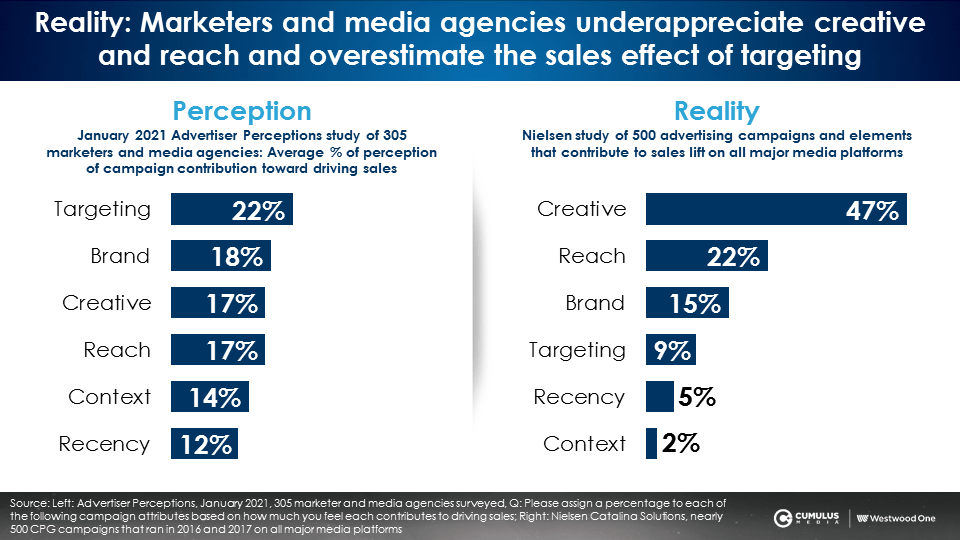
Key takeaways:
- Targeting: Marketers and media agencies overestimate the impact of targeting by 2.5X.
- Context/recency: The perceived impact of context and recency as sales drivers is overestimated.
- Reach: The sales effect of reach is underestimated by marketers and media agencies. Per WARC, reach is the foundation of media effectiveness.
- Creative: Marketers and media agencies massively underestimate the immense sales effect power of creative.
- Combined, reach and creative represent 69% of sales, double industry perceptions.
Click here to view a 12-minute video of the key findings.
Pierre Bouvard is Chief Insights Officer at CUMULUS MEDIA | Westwood One.
Contact the Insights team at CorpMarketing@westwoodone.com.